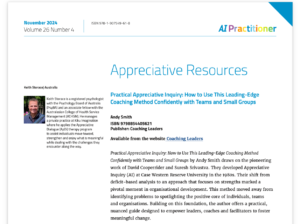How to Facilitate the Dream Stage

[ad_1]

What the Dream Stage is For
The purpose of the Dream stage in Appreciative Inquiry’s 5-D format is to enable us to think beyond our normal parameters, so we can form a vision of the desired future that’s not constrained by what we think is possible.
As Einstein (possibly) said, “You cannot solve a problem with the same level of thinking that led to the problem in the first place.”
I can’t emphasise strongly enough that we are not setting goals at this point. What we’re doing in the Dream stage we’re setting a direction that we want to move in, so it might as well be the right direction rather than some compromise with barriers that might, after all, only exist as social constructs within our existing culture or belief systems. Even if we only ever get a quarter of the way to our ‘dream’, that’s a 25% improvement on where we are now.
Appreciative Inquiry originally came out of the organisational development field, so there are tried-and-tested methods for helping a group to break out of the analytic modes of thinking that they’re used to. For example, you could supply them with art materials and let them create, collectively as a group, a representation of what their ideal future would be like (rather than a quantified and time-bound specification for what a future goal will be like). The group will be using different mental pathways and thought processes than in the traditional problem-solving approaches that they’re used to, and between them can create something that none of them would have thought of individually.
Working with an individual is different (unless of course you and your client are used to using art materials in one-to-one coaching). The client will have to come up with their vision individually. Nevertheless, there are some methods we can use to help them transcend the boundaries of their habitual ways of seeing the world.
Jumping to the Dream Future With the Miracle Question
One method we can use is the ‘Miracle Question’, devised by Steve de Shazer and Insoo Kim Berg in the early eighties. The question is borrowed from solution-focused practice, which has a lot of affinity with Appreciative Inquiry, despite originating in one-to-one therapy rather than organisational development.
The Miracle Question goes like this:
“Suppose a miracle happens tonight while you’re asleep, and the problem disappears completely – what signs would there be tomorrow that tell you that the miracle has happened?”
Framing the question in this way means that the coaching client is freed from having to worry about how to get to their vision, because that might lead them to reject what they really want on the grounds that it’s impractical to get there, and instead settle for something more ‘realistic’ but uninspiring. Instead, because they’re describing a hypothetical ‘miracle’, they don’t need to worry about what they need to do to make it happen – which would probably tip them back into ‘Task Positive’ or analytic mode, damping their creativity.
The aim is for the client to describe their desired future in as much detail as possible. What will they see? What will they hear? What will they be doing? What will that feel like? We’re looking for specific behaviours, actions, and changes rather than vague high-level views. When the client knows how they will be acting differently in the ideal future (it might be getting a bit more sleep or exercise, eating better, building in more downtime, or gaining new skills), they can start acting a bit more that way now, and so bring that dream future a little bit closer.
Another advantage of the client getting specific about describing the ideal future as if it’s already happening is this: experiencing it from an ‘associated’ point of view, as if they were seeing it in reality through their own eyes, gives them access to better-quality information about the vision than if they were describing it merely conceptually, or in a ‘dissociated’ way as if it was happening at a distance to someone else. It’s easier then to adjust the details so that the vision of the future is exactly how they want it.
Recommended Follow-Up Questions
As a follow-up, you can ask “Who else would notice? How would they know this miracle has happened?”
It might be the client’s partner, their work colleagues, their family, their boss… What these questions are doing is inviting the client to step out of experiencing their dream vision, and look at themselves through the eyes of someone else. The only way another person is going to notice that the miracle has happened is by visible changes in the client’s behaviour. So they might say “I’d be smiling more,” or “I’d be going to bed earlier,” or “I’d be devoting an extra half hour to studying.” Through this shift in viewpoint, they may discover some more useful and doable changes they can make.
How to Make the Miracle Question Even More Powerful
When I ask the Miracle Question, I sometimes draw on the experience of my previous careers as a hypnotherapist and an NLP Trainer to make it even more powerful by tweaking the language to add in a couple of embedded suggestions that make it easier for the client to respond to the spirit of the question and give a fuller answer:
“Imagine that while you’re asleep tonight a miracle happens and the problem is completely solved. You don’t realise this, of course, because you’re still asleep – so when you wake up, what will be the first thing that tells you this miracle has happened? What else will tell you?”
“Because you’re still asleep”, while it makes sense to the client’s conscious awareness as just describing their state while the miracle is accomplished, also carries a suggestion that, metaphorically, they haven’t been as aware of what’s going on around them, or as energetic, as they’re going to be soon. It also gives them an out for not solving the problem earlier – how could they, if they were asleep? – so they won’t be as tempted to beat themselves up about it.
“When you wake up” – the “when” presupposes that they are definitely going to wake up (it’s when, not if), so metaphorically they will be more aware, more in charge of their own destiny, and more capable of dealing with the problem. I could add a very slight emphasis to the “wake up” part, so that it becomes what hypnotherapists call an ‘embedded command’ – something that the client can take as an instruction at the unconscious level, while to their conscious awareness, paying attention to the meaning of the words rather than tonality, I’m just saying “when you wake up.”
I may as well add that the “first’ in “what will be the first thing that tells you this miracle has happened” presupposes that there are going to be more things that will be signs of the miracle, and if I add another subtle emphasis to “this miracle has happened”, it’s suggesting to their unconscious mind that it has indeed happened, and so they might want to start looking for signs of it. And if they start looking for signs of improvement, they will probably find them, especially as some of the signs will be changes in their behaviour that are under their control and that they can start making now.
I should emphasise that these are just minor enhancements that you might want to have a go at if you’re NLP-trained, or just adventurous. The real heavy lifting is done by the Miracle Question itself.
I’m starting a new Practical Appreciative Inquiry facilitator training soon. If you like my materials and the way I approach things, this is pretty much the only training I’m doing these days – and it gives you a great method for coaching teams and small groups!
Get full course information, dates, and how to book here
“Andy’s facilitation skills in the Appreciative Inquiry course are truly exceptional. With his expertise and passion for this transformative approach, he creates a dynamic and engaging learning environment that participants find enjoyable and insightful” – Cedrick LaFleur, Author, Chief Executive LaFleur Leadership Institute, John Maxwell Team Executive Director
[ad_2]




